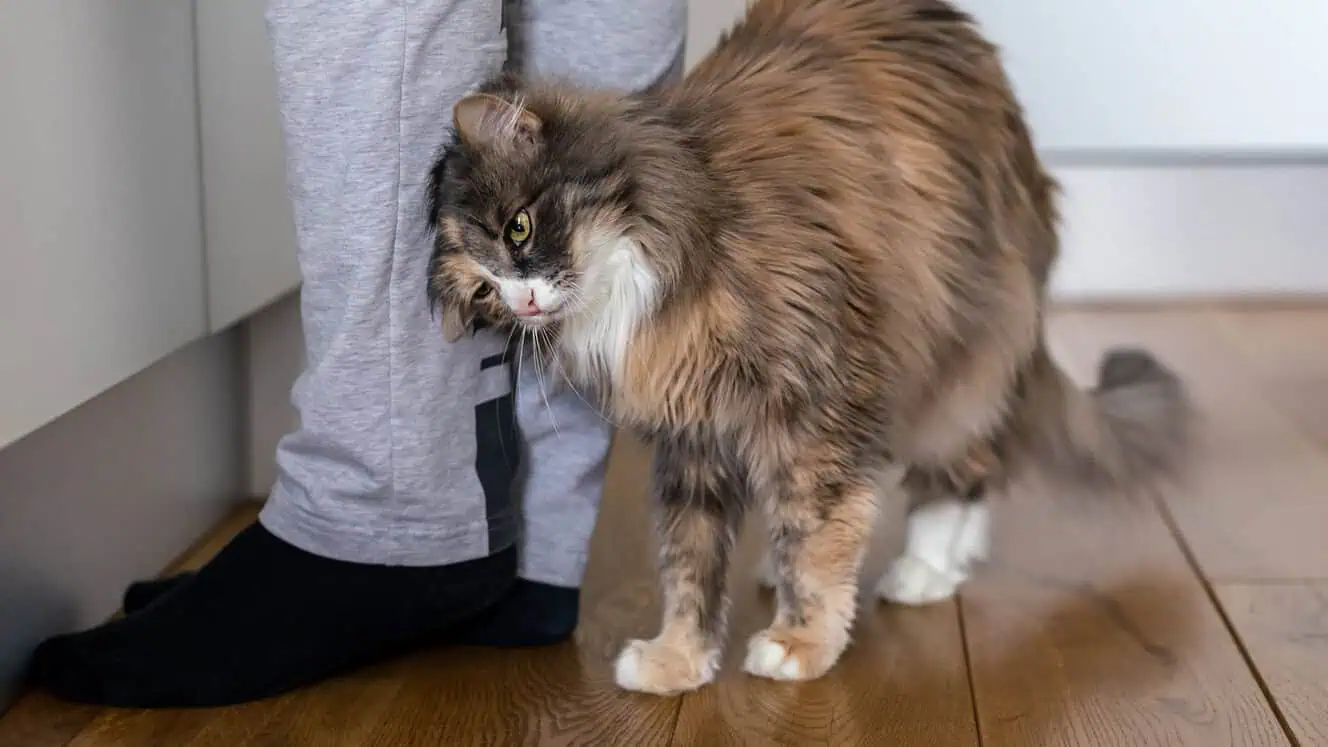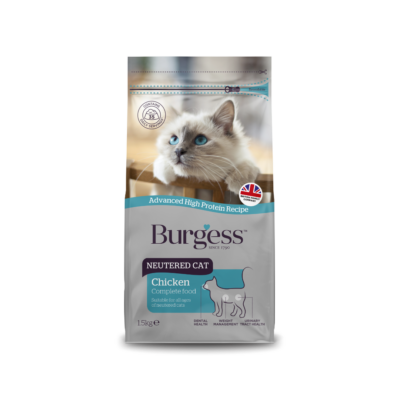
1. WE WANT A HOME THAT KEEPS OUR NEEDS IN MIND
A sleek, minimalist home may look great on Instagram, but cats prefer a more cluttered home styling approach – think slouchy couches, footstools, bean bags, chunky plant pots, piles of cosy cushions and stacks of books. This is because cats love to roam about inconspicuously, darting from behind the sofa to under the side table, with plenty of places to slinkily slip from view.
Many cats also enjoy observing their surroundings from high places, seeking out shelves, cupboards or wardrobes as suitable platforms. Bookshelves can also provide sanctuary if a small area is cleared for your cat’s use – but remove anything in the vicinity that’s breakable.
Secret hideaways, small cosy spaces and secluded sleeping spots are an important facility for cats who need to have private places that are undisturbed. Create these by making space available under the bed, inside cupboards or behind the sofa.
2. WE NEED TO SCENT MARK ALL OUR STUFF TO FEEL SAFE
Are you addicted to the hacks and tips dished out by cleaning influencers who love to show off their sparkling, squeaky-clean homes? Before you start your next ‘deep clean’, be aware that everything in your cat’s world must be anointed by their unique scent signature.
As well as scratching stuff, which fulfils several important feline functions, your cat deposits their scent via glands in their face, body and tail. This is why they continually rub around chairs, door frames, table legs, laptops – as well as their human.
By creating and maintaining a pheromone-drenched home environment, your cat feels safe and secure. So, although good hygiene around the home is important, bear in mind that too much vigorous cleaning can be quite disturbing for your cat.
3. WE WANT OUR RESOURCES IN JUST THE RIGHT PLACES
Cats like to make their own decisions and feel in control of their environment, which is why they can be a bit finicky about where their resources are located. Rather than having everything – such as food, water, litter tray, scratching post and bed – all in one place, cats tend to prefer them to be positioned in different locations around the house.
In particular, as cats originally evolved in dry, desert environments, their motivation to drink is not connected to hunger – unlike us, they don’t want to eat and drink at the same time. In fact, many cats find it confusing when water bowls are provided next to their food. Instead, provide fresh water in alternative locations away from your cat’s dinner and, if your feline friend prefers running water – as many cats do – invest in a pet drinking fountain to encourage them to stay hydrated.
If there are any of resources your cat is not using, try moving things around to see if it’s the location that’s the problem.
4. WE FIND CHANGE RATHER STRESSFUL
Cats are, by their nature, more independent than dogs – in part because their wild relatives don’t live naturally in the same sort of family groups that canines do. Groups of dogs have to communicate with each other, whereas cats – small hunters who operate alone without back-up – are hardwired to think about number one.
That’s why cats have an in-built need to feel in control of their environment and can find change extremely stressful – even a new carpet or sofa can set alarm bells ringing as it disrupts the scent profile they have worked so hard to create and maintain. Help your cat to feel safe and happy by surrounding them with familiar things and keeping their home and routines predictable and consistent.
If some household changes are about to take place, try some calming synthetic pheromones such as Feliway or Pet Remedy. These work alongside the brain’s neurotransmitters, which are messengers that tell the nerve receiving the message either to get ‘fired up’ or ‘calm down’, to reduce anxiety and stress.
5. WE WANT OUR OUTSIDE SPACE TO BE AN INTERESTING PLACE TO INVESTIGATE
Just like a clutter-filled home, a less than pristine garden will win plaudits from your cat. For a feline-friendly outdoor haven ditch the neat flowerbeds and tastefully trimmed shrubs and opt for tall ornamental grasses, dense bushes, interesting places to climb, hide and scratch, along with sprawling sensory plants such as catnip, honeysuckle and sunflowers to dart in and out of.
For vulnerable felines – such as those that are elderly, deaf or have other health problems, you could construct an enriching outdoor area using cat-proof fencing, a cat enclosure or catio. This should be an alfresco space where your cat can enjoy the fresh air and watch what’s going on while staying safe. Include cat-friendly plants, such as bamboo, cat grass, catmint and lavender, a variety of accessible shelves at different heights, a cosy hiding place out of the sun and a cat water fountain.
6. TERRITORY IS VERY, VERY IMPORTANT TO US
One of the strongest traits of cat behaviour is territoriality. Every cat spends much of his or her time familiarising themselves with an area (your house, garden and immediate vicinity), patrolling, monitoring and defending it. This instinct is due to hard-wired genetics linked to protecting resources and safe spaces – and other cats who trespass on this territory are regarded with deep suspicion.
In fact, where there are several cats in one neighbourhood, a kind of territory time-share develops. Common areas are crossed at different times of the day so that neighbouring felines can go about their business while managing to avoid each other.
If your cat has had an unwelcome encounter with another feline, they may become reluctant to spend time outdoors. Try accompanying your cat outside to give them confidence (you can also shoo off any unwelcome interlopers) and install a microchip-operated cat-flap that only admits entry to your cat, so that other cats can’t access their safe haven.
7. WE NEED COMPANY
While many cats are suspicious of people they’ve never met who enter their home, they relish the company and attention of their favourite human.
Even though cats are naturally self-contained creatures – they have evolved from solitary and independent ancestors that don’t live naturally in family groups – it doesn’t mean they enjoy being constantly left to their own devices. While every cat is an individual, most will get lonely and stressed if left on their own for too long.
And, clever cats have devised all sorts of ways to get their human’s undivided attention, whether that’s in the middle of the night or while you’re busy doing something else.
Cats Protection says: “If your cat likes fuss and strokes, they may choose to sit somewhere that will increase their chances of getting your attention. The laptop you’re using, paper you’re reading, chair you’re sitting on, or your lap are prime positions for getting in your way, so you give them a chin rub.”
However, cats like to initiate contact on their own terms. While some relish their life as a cosy lap cat, others don’t really enjoy being picked up or cuddled. While humans love to embrace, for a feline, a cuddle can make them feel trapped. That’s why, when cats are held and prevented from having an escape route, they may become fearful or aggressive. For some felines, just spending time in the same room as you is their way of saying they love you.
And, while some cats will tolerate or even develop friendships with dogs, bringing home a new cat as a ‘friend’ for your resident feline may not be appreciated. While humans may think their solo feline will enjoy the company of playmate, your cat is likely to have other ideas. To them, this new arrival is an unwelcome intruder from whom all resources – food, toys, top sleeping spots etc – must be fiercely guarded. So, while some felines may eventually adapt to the presence of another cat, for others, it’s a pawstep too far and fur will fly.
8. WE LIKE TO PLAY
Whatever their age, all cats benefit from playtime with their human. As well as being lots of fun, play teaches young cats and kittens about the world around them, aids their physical development and hones their fabulous feline skills.
As cats get older, play is a great way to stay fit, lean and healthy, as well as keeping their brain alert. The best games are those that make the most of their natural repertoire of behaviours – stalking, pouncing, chasing and batting objects with a paw, exploring, climbing, jumping and patrolling.
These ‘hunting’ skills, replicated by pursuing or swiping at a toy, release feel-good hormones called endorphins, which boost feline feelings of wellbeing. Play is particularly important if you have a cat that spends most of their time indoors.
Older cats may enjoy playing three or four times a day, while younger cats will be happy to play 10 times a day or more. Playtime doesn’t have to be prolonged and has the most beneficial effects if it’s provided relatively frequently in short energetic bursts of activity.
9. WE APPRECIATE IT WHEN YOU TRY TO UNDERSTAND US
From purrs to scent signals, body postures and tail movements to blinking, yowls, growls and meows – a form of communication that cats have developed just for us humans – our cats are constantly telling us how they’re feeling. However, it’s up to us to make the effort to understand.
Cats Protection advises: “Cats are subtle and complicated in the way they communicate, but taking time to learn their body language can help to strengthen the relationship with your cat. Learning the signs that they are happy, or when they just want to be left alone, can be a big help to you both.”
Each cat is unique – some are anxious, others are bursting with confidence. Just like us, they don’t always get on with everyone they meet, and they like to pick their own friends, not necessarily the companions we choose for them. By learning to understand your cat and providing them with the opportunity to be a master or mistress of their own destiny – in terms of their home and resources and how and when they use them – you’ll enable your cat’s true personality to shine through and discover just what a wonderful companion your fabulous feline can be. You’ll also have a very happy cat!
10. WE ARE CARNIVORES WHO NEED TO EAT MEAT TO SURVIVE AND THRIVE
All cats – from tigers to domestic tabbys – are what’s known as ‘obligate carnivores’, which means their nutritional requirements can only be met with a diet based on animal tissue – so cats cannot be vegetarians or vegans.
Burgess in-house vet, Dr Suzanne Moyes MVB MRCVS, explains: “As obligate carnivores, cats must eat meat to survive. Meat contains essential amino acids which they can’t make themselves. Cats also require high levels of protein and a careful balance of at least 13 different vitamins, plus the essential amino acid taurine necessary to promote a healthy heart and eyes. A complete diet will have all the necessary vitamins, minerals, essential fatty acids and amino acids in the right ratio. Dry food is a good option as it’s easily portioned, may be better for dental health and encourages extra water consumption.”
11. WE QUITE LIKE FEEDING TIME TO BE A BIT OF A CHALLENGE
In the wild, cats have to work for their food, which exercises their bodies and stimulates their minds. According to Cats Protection, wild cats make around 40 hunting trips a day (with around one in four forays being successful) so much of their time and energy is taken up with stalking, chasing and catching prey.
Food predictably dished out twice a day in a bowl in the kitchen presents no kind of challenge. By getting creative when it comes to feeding time and providing some of their daily ration of delicious cat nuggets in feeding balls or cat puzzles you can deliver a much more exciting and rewarding experience for your cat.
12. WE NEED YOU TO HELP US STAY SAFE AND HEALTHY
From neutering to vaccinations and regular check-ups at the vets, to grooming, parasite prevention and dental care, as well as providing the very best nutrition and protecting them from danger – humans play a vital part in keeping their BFF (best feline friend) safe and healthy. From their crazy kitten days to their golden years – our cats rely on us to help them live long and happy lives.
EVERY CAT DESERVES A DELICIOUS, NUTRITIOUS DINNER!
At Burgess Pet Care, all our cat food is made using premium ingredients to ensure excellent quality and superior taste to help keep your cat happy and healthy – from kitten, to adult and mature and our award-winning variety for neutered cats – available in a range of sizes.
- Salmon? Duck? Chicken? Let your adult cat pick their favourite flavour with our fussy cat bundle >>
- Our cat diet and nutrition guide is here to help you create a meal plan that's tailored especially for your feline friend.
- How often should you feed your cat? Find out why little and often suits most cats – and the reason why play should be part of your feeding routine.
- Adapting your cat’s diet throughout their life What you choose to feed your cat can make all the difference.
WHY CHOOSE BURGESS CAT FOOD FOR YOUR BEST FELINE FRIEND?
Here are 5 good reasons that your cat will thank you for!
- COMPLETE NUTRITION Each of the recipes in the Burgess Cat Food range are complete, providing all the nutrients cats require throughout their life in exactly the right proportions.
- PORTION CONTROL With dry food, it’s easy to measure out the right sized portion to help your cat maintain a healthy weight.
- HEALTHY AND SAFE The thorough cooking process ensures that any harmful bacteria, such as salmonella, and viruses are destroyed, and the dry food stays fresh inside the pack.
- TEETH FRIENDLY Dry cat food has the added benefit of exercising your cat’s chewing muscles and provides a mild cleaning effect on the teeth.
- MADE IN BRITAIN Crafted at Burgess Pet Care’s own factory in the heart of Yorkshire by vets and animal nutrition experts, Burgess Cat Food contains high-quality ingredients that meet stringent specifications, locally sourced wherever possible to support British farmers.
But don’t just take our word for it! With a whole host of *5-STAR reviews*, Burgess cat food customers have told us:
* “My cat will not eat wet salmon food but loves this dry variety.” * “We have an old cat and thought we would try it as she seems to have gone off her normal varied food. She loves it.” * “Cats absolutely love it. Couldn't wait for me to open the bag. As one tried to eat through the bag to get to the fishy goodness.” * “Cats really, really love them.” * “It’s great value to buy the large sacks. It arrived promptly. My cat is always keen to eat every last crumb.” * “My cats love it – they can't get enough!” * “Cat loves the food and helps keep him in great health.” * “Kittens love it.” * “My cat loves it, seems to have eased her urinary tract issues too.” * “This is my cat's favourite dry food. *
Is your cat a Burgess cat? Join the Burgess Pet Club for exclusive offers and rewards.
If you found this interesting, you may also like:
CAT BREEDS – TAKE A CLOSER LOOK AT SOME OF THE UK’S MOST POPULAR TYPES OF CAT Siamese or Bengal? Norwegian Forest or Maine Coon? Ragdoll or Russian Blue? Which breed of cat do you find most captivating? We count down 10 cat breeds that are riding high in the popularity charts, plus one favourite feline that’s not actually a breed at all…
ARE YOU AND YOUR CAT MORE ALIKE THAN YOU THINK? If you have a grumpy Tabby cat, a super friendly Ragdoll cat, or fiendishly feisty Bengal cat, could this actually say more about you than your pet?
THE NEXT BIG STEP FOR YOUR LITTLE CAT When does your kitten become a cat? What changes will you see in their behaviour? When do you need to switch them over from kitten to adult cat food – and what are the nutrition differences that benefit them as they grow?
HOW TO TELL IF YOUR CAT REALLY LOVES YOU While you may adore your captivating cat, how does your enigmatic feline companion feel about you?
CAN YOU TRAIN A CAT? Felines excel at training their human guardians to give them food, attention and a cosy lap to curl up on. But is it possible for us to train them?
MUSIC TO THEIR FURRY LITTLE EARS? What’s on your playlist? Cat Stevens? The Stray Cats? The Pussycat Dolls? And have you ever wondered if your cat appreciates your taste in music, or would they prefer music created especially for them? Yes, it’s a thing!
PLAY BEHAVIOUR OF CATS SUPRISES SCIENTISTS While there are lots of things that cats do which cause scientists plenty of head-scratching moments, new research into the way that cats play has resulted in some rather baffled boffins...
SHOULD LILIES CARRY A HEALTH WARNING? Did you know that lilies are so poisonous that a cat can suffer fatal kidney failure just from nibbling a leaf, licking pollen off their coat or even from drinking water from a vase with cut lilies in it?
DOES YOUR CAT RECOGNISE YOUR HAPPY FACE? How do cats see humans? Do cats recognise faces? Do cats remember people? Do cats miss their owners? Do we own cats or do cats own us?
IS YOUR CAT REALLY MAD AT YOU? Whether it’s because you’ve had to take them to the vet, or you accidentally stepped on their tail, your cat may give you the impression that they’re really cross with you. But can cats really hold grudges?
HOW TO HANDLE YOUR CAT Cats like to feel in control of whatever situation they’re in and are quick to show when they’re not happy. Never is this more evident when it comes to being handled when they don’t want to be.
MY CAT IGNORES ME – WHY Unlike dogs, who generally want to be involved in every situation, cats are known for being independent. While some cats can be quite social, it can be hard to take when your favourite feline seems to take absolutely no notice of you. So why is this the case?
COME IN FROM THE COLD Practical ways from feline experts to help your cat cope with winter.
GIRLS V BOYS – FELINE MYTHS AND MISCONCEPTIONS Do male and female cats act differently because of their gender? Are generalisations about laid back, lap-loving boys and aloof, independent girls simply myths – or is there any truth to them?
DOES YOUR CAT KNOW THEIR NAME? Whatever name we choose to bestow upon our beloved pet cats, does it make any difference to them? Do they actually understand that they’re called Alfie or Bella or even Archibald von Snugglemuffin?
THE HOMING INSTINCT – CAN CATS REALLY FIND THEIR WAY HOME? Top tip – it’s much easier if they’re microchipped! Plus, what a change in the law will mean for every cat owner…

















